Hot Springs Watershed Online
Activity
Introduction: The Hot Springs
Moose
North Central Idaho is home to
many beautiful and amazing features. In this area lies the
Selway Bitterroot Wilderness, Idaho's first officially
designated wilderness area. The wilderness is home to many
different types of wildlife, and sustains a healthy population
of moose.
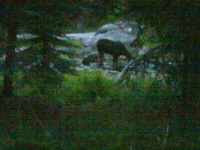 The
Selway Bitterroot Wilderness is an area in which a hot springs
well-known to backpackers and outfitters is also located. This
hot springs, known as
Stanley Hot Springs
(not to be confused with the town of Stanley, Idaho), is a
favorite of hot springs enthusiasts because of a moose that
frequents the springs at dusk almost every night during the
warmer months. The
Selway Bitterroot Wilderness is an area in which a hot springs
well-known to backpackers and outfitters is also located. This
hot springs, known as
Stanley Hot Springs
(not to be confused with the town of Stanley, Idaho), is a
favorite of hot springs enthusiasts because of a moose that
frequents the springs at dusk almost every night during the
warmer months.
Typically, at or near dusk, the
hot springs moose makes a journey to Stanley Hot Springs to feed
on the lush vegetation that surrounds the hot springs pools,
and, according to the locals, enjoy a hot soak.
Why Idaho is Unique in Regard
to Hot Springs
Idaho has the most usable hot
springs out of any other state in the United States, with about
130 soakable out of 340. However, Nevada has the most hot
springs overall, but the majority of them are not soakable -
they are too hot!
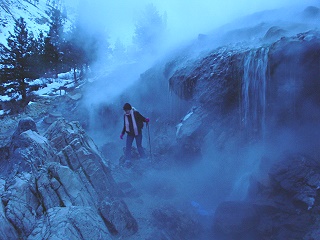
Hiking to
Kirkham Hot Springs,
near Lowman, Idaho
What Makes a Hot Springs Hot?
The water is hot because it is
heated from within the Earth's crust, forcing it up to the
surface where pools are developed or form naturally near the
outflow.
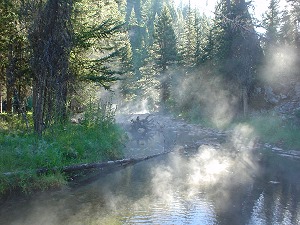
At
Bear Valley Hot
Springs in Idaho, hot water collects in large pools and
cools as it spills into a chain of lower pools (with lower
temperatures) before reaching Bear Valley Creek
Common Uses of Hot Springs
- Humans use hot springs
recreationally, to soak in. They also harness energy from
the hot water (geothermal energy - more on this later) as a
means to provide a more efficient, renewable energy
solution. The harnessed energy is used to heat homes and
power greenhouses, and the hot water is used to raise fish
and alligators.
- Animals feed off the lush
vegetation that grow as a result of the hot springs water.
In Stanley, Idaho entire herds of Elk are able to survive
the harsh winters because of the valuable food made
available by the hot springs. The hot water outflow melts
ice and snow, leaving lush vegetation exposed even during
the most brutal of winters.
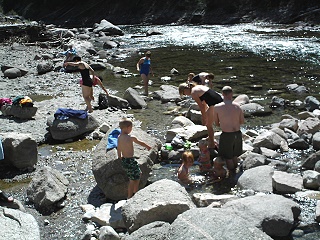
Sunbeam Hot Springs
is popular with families
Hot Springs Inquiry
If you've lived in Idaho long,
the chances are you've already been to or know of a hot springs.
Most of the hot springs in Idaho are on public land, like
National Forest or Bureau of Land Management (BLM) land. Hot
springs on public land are usually free to visit and feature
naturally formed or user-built pools designed and built by
volunteers, many of which work for the public lands.
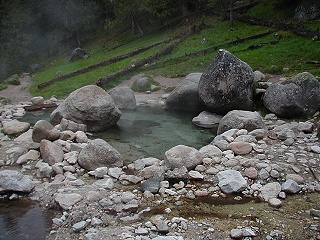
Idaho's most popular hot springs:
Jerry Johnson
Hot Springs in Idaho, near Missoula, Montana
Idaho is home to another type of
hot springs, where humans have developed the land on and around
a hot springs into a commercial resort, spa or rustic retreat.
There is usually a fee of some sort associated with using these
types of hot springs which feature concrete pools that are often
enclosed.
Think Quick! Can you name any hot
springs in Idaho that you have been to or know of? Think hard
(not too hard!), then
click here to
view a list of public hot springs names.
|
Activity: Journey To a Hot Spring |
|
Each molecule
of water contains two atoms of hydrogen and one atom of
water. As groundwater heats up, the water molecules
become very active and begin their journey up faults,
cracks and loose rock in the earth's crust to the
surface where the hot water (molecules) form hot
springs.
Become the Water Molecule
Have your
students, friends and/or family members stand in small
clusters which represent cool water molecules.
As cool
water falls from the sky in the form of rain it collects
on the surface of earth. Some of the water makes its way
down into the earth's crust through loose rock and
faults.
Cool
groundwater is slowly warmed up by hot rocks below the
earth's crust. You can demonstrate
this by having the 'water molecules' begin to slowly
move around, but stay in place. It is not time to
leave clusters, yet.
As the heat
from the rocks is transferred to the water molecules
they become increasingly active - to the point where
they being to travel upwards, towards the surface of the
earth. You can demonstrate this by
having everyone increase their movements and being to
slowly span out from their clusters.
As the hot
water molecules make their way toward the surface they
begin to lose some of their heat, and even more when
they finally exit the ground and hit the cool air of the
surface. After having everyone
span out, have them slow down their movements and begin
to slowly return to their clusters.
After
exiting the ground the hot water molecules form pools on
the surface where they continue to cool in a hot spring.
At this point you can either take
the water molecules to gas form, up into the atmosphere
to continue to activity, or you may return them to their
original state. |
Conserve, Preserve and Protect
Here are some things to think
about when using hot springs recreationally, on public land.
- Tarps - Tarps left in hot
springs produce a foreign fungus which does not break down
and is harmful to the surrounding environment and ultimately
makes its way into our local water systems.
- Camping - Keep campsites at
200 feet away from all water sources. Any pollution that
gets in threatens fish, wildlife and human drinking water.
- Cooking - Cook at least 200
feet away from all water sources for the same reason as
above.
- Bathing - Hot springs are
not for bathing. All soap, even bio-soap introduces harmful
contaminates that do not break down into the water system.

Stanley Hot Springs
near Lowell, Idaho
Internal Activity
References/Resources
External Activity
References/Resources (open in a new window)
[TOP] |